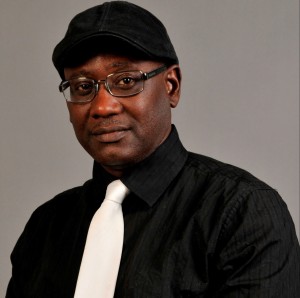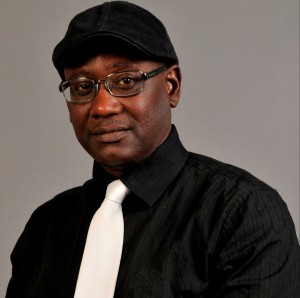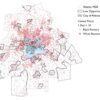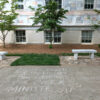This is the second installment in our series of interviews that complement Julia Brock, Teresa Bramlette Reeves, and Kirstie Tepper’s piece “Arts and Activism in 1970s Atlanta” by highlighting the continuing pertinence of the issues in the article in Atlanta today.

The subject of this interview is Kevin Sipp, an Atlanta-based artist, and the curator of Gallery 72, a municipally owned art gallery located in of downtown Atlanta, and formerly a curator at the Hammonds House Museum. Sipp’s experiences at these two very different institutions, which both emerged out of the 1970s art scene that Brock, Reeves, and Tepper describe in their piece, give him a unique perspective on the current art scene in Atlanta and its relationship with public funding and the city’s diverse communities.As part of the city’s current ELEVATE arts festival (Oct. 13–21, 2016), Kevin Sipp has curated an exhibit at Gallery 72 entitled Sisters Song: Awaken. As he describes it, this isan “all-women exhibition that explores, from a womanist perspective, the impact that migration, development, and gentrification have on the city’s inhabitants, old and new. The hopes, fears, tensions, and collaborations that grow out of the changing racial and cultural narratives of contemporary Atlanta is the nexus of the presentation.” Organized in coordination with a piece of performance art by Chroma for ELEVATE, the exhibit will remain on view at Gallery 72 until Nov. 11, 2016.
To start us off, could you tell us a bit about where you see the Hammonds House Museum fitting in the arts ecology and arts economy of Atlanta?
When the Hammonds House was founded, it was at a time in the late 1980s when many people in the African American community felt institutions like the High Museum weren’t bringing in major African American artists to the Southeast and exhibiting them. So Hammonds House was specifically trying to establish the lineage of African American contribution to the history of American art and to the history of world art. And I just think it was a fundamental space for the establishment of African American art in Atlanta. The ecology they created, for bringing in nationally and internationally acclaimed African American artists, when there weren’t many spaces that could do that, became very important to growing Atlanta’s African American art community. But it was really the culminating space, that had been seeded in the 1970s – by Dr. Richard Long, by O. T. Hammonds and his art collection, by all the creative arts practitioners here in Atlanta who had been establishing their own independent spaces or city-funded spaces or county-funded spaces like the Neighborhood Arts Center. At that time there had been a clash between two art economies, the Old South money funding the High Museum and the New South black economy, which in some ways is still being felt today.
Now when we say art economy we are talking about sales, we are talking about promotion, and we are talking about funding artists to do work. The Hammonds House was a very good space because artists did get to sell their work out of the exhibitions that we had when I was there. The museum got 20 percent and the artist got 80 percent. So we were not operating like a commercial gallery, which was good. Ultimately, I think the Hammonds House contribution to the art economy of Atlanta was profound because while I was there, a lot of people became patrons of the arts simply by coming to the Hammonds House, coming to the programming, learning about art, learning about the history, learning about the importance of art to the history of African American traditions. And as a result they began to see the importance of buying and supporting art and supporting artists. I know there are a lot of people who are now happy they purchased Radcliffe Bailey’s works from his shows or purchased Fahamu Pecou’s works. You know I remember when he had shows at the Hammonds House and you know people may not have known where he was going but I’m sure they’re happy they got some of those pieces now. So, the very fact of a space like the Hammonds House – showcasing black artists and facilitating the sale of their works – that’s directly keeping a black artist fed and thriving so they can make more art.
Similarly, could you tell us a bit about how you see Gallery 72 fitting in the arts ecology and arts economy of Atlanta?
So, Gallery 72 was founded in 2014 through the initiative of Mayor Kasim Reed, with executive officer for the Office of Cultural Affairs, Camille Love, also moving that forward. It was established to be a space to show contemporary art in the city of Atlanta and it was also a way for the city to show its commitment to showing such work. When the Sears building was sold and it was turned into Ponce City Market, we lost City Hall East, which had for years housed a large and incredible arts space. Almost an entire lower level of what is now Ponce City Market was a dedicated art space. When the city lost that space, they wanted to establish a new venue to show contemporary art.
Gallery 72’s mission is to show contemporary Atlanta-based art and sometimes regional, national, and international art. Being a city gallery, the mission already has integrated into it the need to not only show contemporary art but to be representative of the diversity of the art scene in Atlanta. Which means it can’t just be a space that shows certain niches of people but has to pull in the entire Atlanta metro community of artists. So it’s a different mission. And it requires outreach to a more diverse audience. When I was hired, my stated mission for Gallery 72 was to make sure that it became an international gallery simply by reaching out to the international community that’s based here in Atlanta. We don’t have to go all around the world to be international, there is a thriving immigrant community, a thriving refugee community, we have pockets of incredible East Asian communities, South Asian communities, Latino communities – you name it, its here. But how do we integrate the artists from those communities into metro Atlanta galleries?
As for Gallery 72’s relation to the arts economy, like the Hammonds House it also has a mechanism set up for sales, but it is still in flux a bit. When I first came in, the city public art manager was telling me we’re not in the business of selling art, but if people are interested we can get them in contact with the artist and the artist gets 100 percent of the proceeds. That way the city is not caught up in the bureaucracy of selling art – and trust me, it would become a bureaucracy. But now people are saying maybe we should do something like the Hammonds House, so they’re looking at finding a mechanism to accommodate that.
One of the reasons the city was very interested in establishing Gallery 72 as a replacement for the art space in City Hall East was the idea of being a player in the arts economy. But the city’s investment in the arts goes well beyond Gallery 72. For example, a lot of people tend to forget that before Broad Street became a locus for art in the city, that’s where ELEVATE established itself and did its programming. This is what made people even think about Broad Street as an arts district in the first place. So they pretty much jump-started that by having these murals painted on those vacant buildings. And then before you know it people were starting to look at them as arts spaces and now they have become arts spaces. So the city understands that art is a part of development. Unfortunately, development has a tendency to consume those spaces once the artists have established them. I call it the “bohemian stormtrooper legacy.” The creatives are always willing to go where scared folks aren’t for various reasons – I won’t get into those various reasons – and they will become like homesteaders and pioneers, but once they’ve established a space as semi-safe, then the developers come in, buy a building, purchase a space, bank it – land bank it – till the real big development comes in, which kicks the artist out.
In their article “Arts and Activism in 1970s Atlanta,” Brock, Reeves, and Tepper suggest that public support of the arts was one of the crucial elements in the creation of a dynamic art scene in Atlanta in the 1970s. But some of the other people we have spoken to suggest that public support of the arts today is insufficient. We were wondering if you could tell us how you see the state of public support for the arts in Atlanta today and its effect on the art scene.
So I have a unique perspective on this because I worked for a gallery – the Hammonds House – and now I’m working for the city. And one of the things I learned at the Hammonds House, and now with the city, is that everybody thinks you have more money than you’ve got and that, therefore, your money, the money that you have, should basically fund their idea because they don’t have any money to fund their idea. But while they might want the city to become a venture capitalist, that’s just not what a city is. A city is not a venture capitalist and there is not an infinite well of taxpayer money. Working for the city now, I’ve come to understand how important it is to recognize that the city’s money is taxpayers’ money and we have to justify what were doing to the public. And if the public is saying why are you giving this money to an arts organization when my sewer needs fixing, those are the kind of things you have to balance out and prioritize.
But there is also the problem of awareness. The city has a great program called Contracts for Arts Services, which is a program where artists can apply for grants from the city to fund their projects or arts organizations. So it can be a little as $5,000, $10,000 – even $15,000. And the county has a similar program where they have funding that people can apply for to fund their projects and I think that’s a great program that not enough artists know about until its too late. They always find out afterwards, and are wondering why no one told them – though we do workshops all year. So, I think we need to have something like a get out for the arts campaign, like we have a get out the vote campaign, because there are a lot of creatives who just aren’t on the grid. Sometimes you have to do a little more due diligence to make them aware of these kinds of opportunities.
But alongside those demanding more from the city you have a whole other ecology in the arts community that doesn’t even care about those things. Places like City of Ink and Notch 8 and the LiFT Salon, where people say we are not gonna wait around for public funding, it’ll be good to get some money, but if we don’t we will find ways to do things ourselves anyway because we see a need. And we also see that if we showcase certain things, sales might get made, and we might get our cut and things can get funded. The DIY approach that started with punk and rap is still very much alive in the art world in these kinds of spaces.
You have already spoken about this in your discussion of Gallery 72, but could you tell us more about how you see the changing racial composition of the art scene in Atlanta?
When we talk about race in America, we have a tendency to polarize it into black and white, and there are a whole bunch of other communities who feel left out of the dialogue. So, yes we can talk about the historical racial makeup of the city, but when you move forward to where we are now, things are no longer just black and white. So it has become much more complex. As of a few years ago, Clarkston, Georgia – where I live – became the most diverse community in all of America, which is phenomenal. So you have this incredible international immigrant community. But is anyone bringing them into the dialogue of race in Atlanta?
How we bring in all these diverse groups into an art economy and art ecology is what really interests me. As I told someone the other day: Atlanta doesn’t have an identity, it has identities, and we just need to accept that. And global doesn’t always mean corporate. What I love about Clarkston is that it is almost a colloquial global, it’s like downhome global – as opposed to a corporate global. That’s a global that people don’t often talk about. And I’m really excited about the second generation and third generation immigrant communities, with kids who are being born here, who are straddling these two worlds. I was at an Eritrean Independence Day celebration and this kid was up on stage with a thousand-year-old instrument and he’s rapping. That’s the future of Atlanta.
Citation: Newman, Adam P. and Clint Fluker. “Arts and Activism in Atlanta Today: An Interview with Kevin Sipp.” Atlanta Studies. October 20, 2016. https://doi.org/10.18737/atls20161020.




